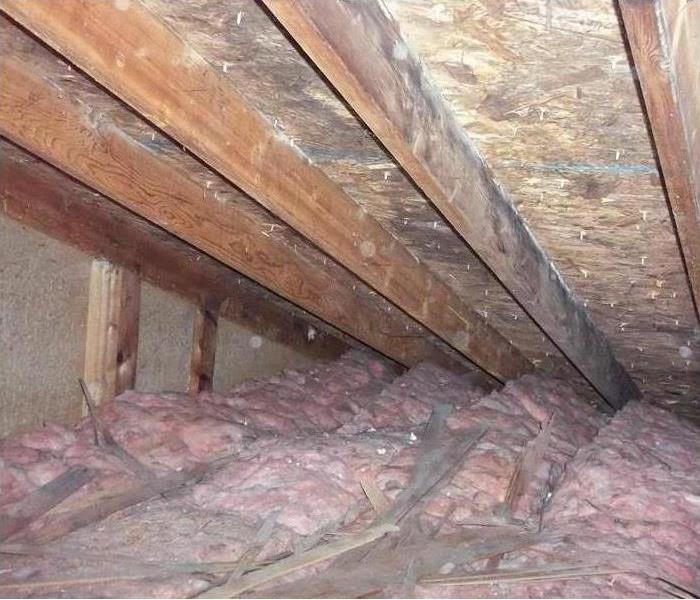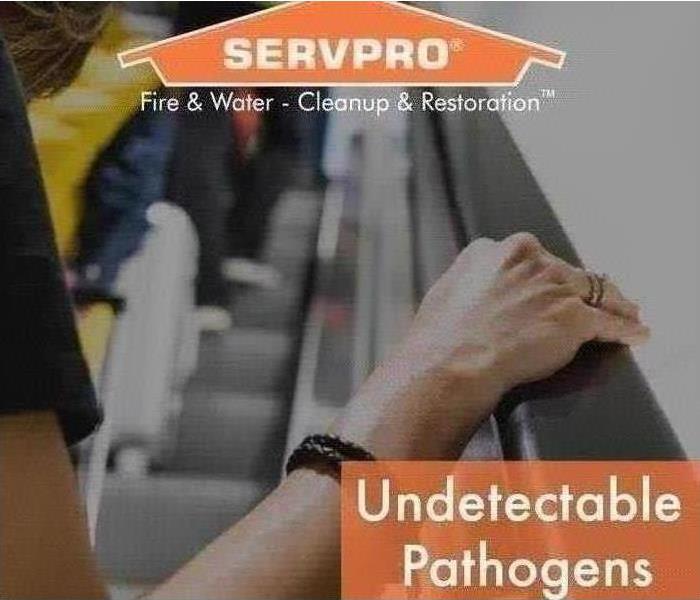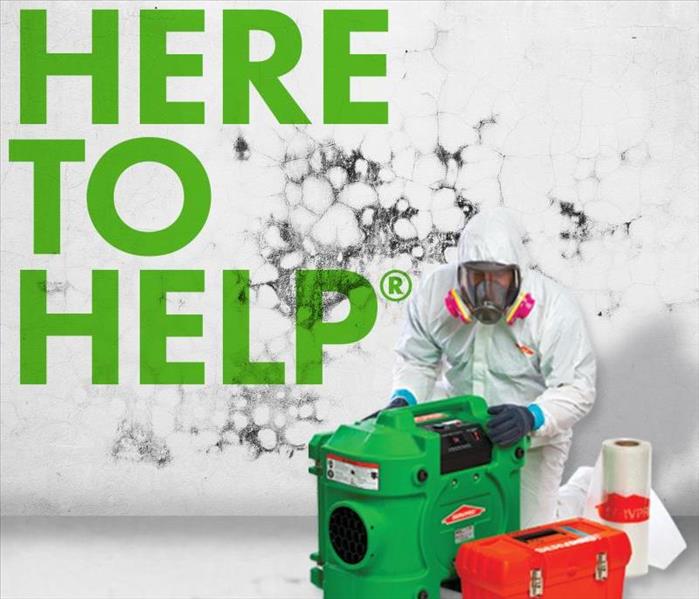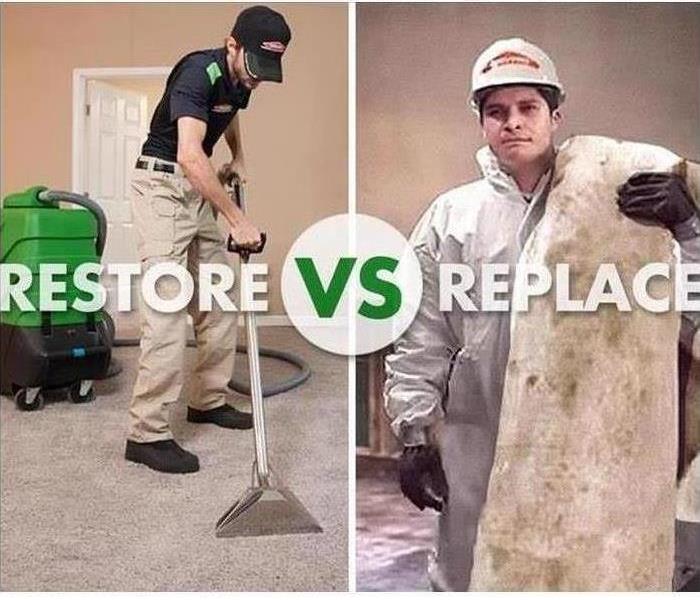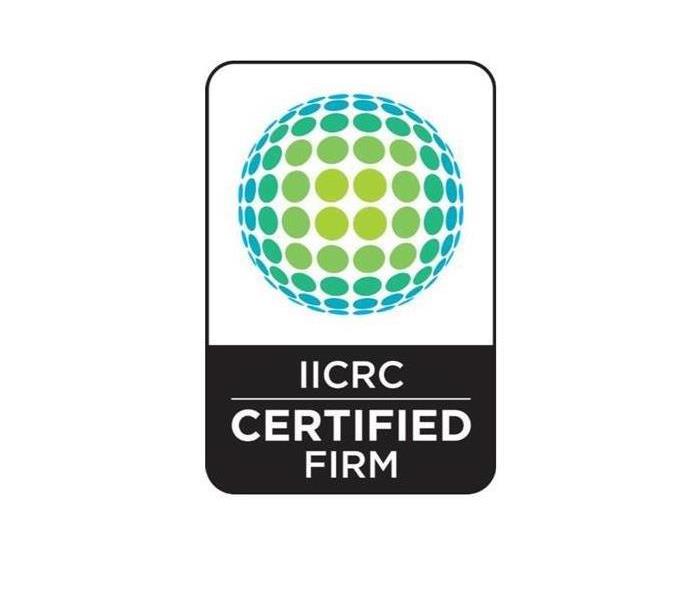Recent Why SERVPRO Posts
3 Reasons To Invest in Business Insurance
9/4/2022 (Permalink)
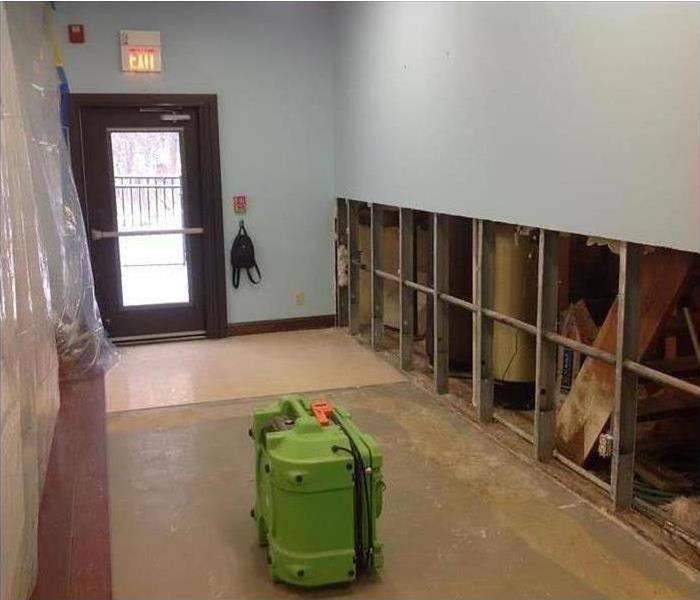 Water damage can come from just about anywhere.
Water damage can come from just about anywhere.
Business Insurance
If your commercial property in Mahtomedi, MN, has suffered water damage, contact insurance immediately seeking aid. Most insurance policies cover some water intrusion, such as busted pipes. Your agent can collaborate with a water restoration company to ensure that the building receives appropriate cleanup and provide financial help.
1. Minimize Your Out-of-Pocket Costs
Repair bills for broken pipes can be quite large. The lines themselves must be mended; then, the property must be dried, cleaned and restored. This process is timely and could require revamping much of the space, costing well within the thousands. Many owners do not have that money saved, and a bank loan means facing undesirable interest. With an insurance policy, owners pay a deducible. The agency handles the rest of the funds, at least up to the coverage amount.
2. Receive Thorough Professional Restoration Services
The insurer may not love writing over a large check, but the agency certainly needs to protect the asset and avoid future claims. Before financial assistance is granted, the agency insists on their adjuster seeing the building, determining what should be done. They also monitor the completion request to ensure that everything you need is covered. It's an extra set of eyes to safeguard you and your establishment.
3. Cover Property Loss and Damage
During a water cleanup, the crew may extract drywall and carpeting since there are difficult to sanitize thoroughly. Also, the team looks over any other drenched valuables, considering whether they are salvageable or not. While their content cleaning employees may be able to treat electronics and important documents, much of the saturated items are likely tossed. Insurance policies cover the restoration of the structure and the replacement of lost belongings, saving you the hassle of paying for them yourself.
Water damage remediation adds up quickly. Having an insurance policy is an owner's lifeline, offering the reassurance that the premises receive proper care at an affordable rate. The monthly investment pays off when calamity strikes.
Choose the Leader in Fast Emergency Response
7/30/2022 (Permalink)
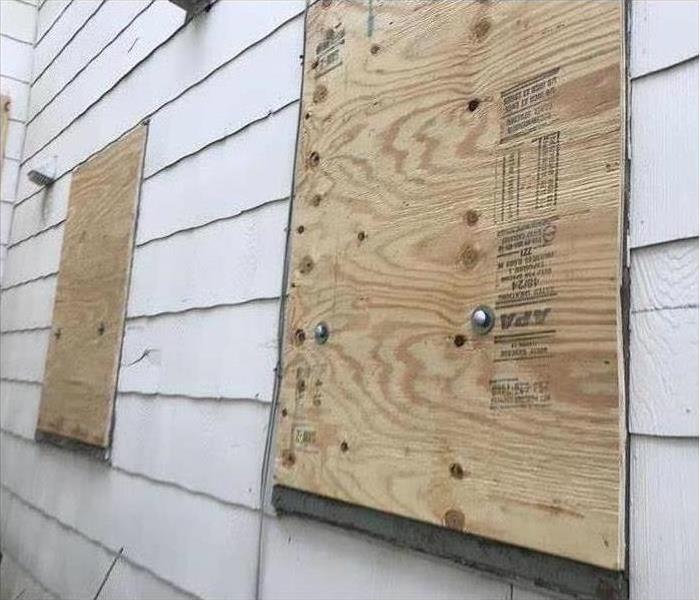 Board up windows in a home in Mahtomedi, MN.
Board up windows in a home in Mahtomedi, MN.
Pick the Best for Quick Emergency Response
Fires, storms and flooding can all cause damage to your property and require professional repairs. Delays in the restoration work may create further damage to your Mahtomedi, MN, home, or business. It's therefore critical to initiate swift emergency response to keep you and your property safe. SERVPRO's local franchise network guarantees a response Faster to Any Size Disaster. Give them a call and expect their team to quickly arrive on-site to survey the damage and form a restoration plan.
Get Help Faster to Any Size Disaster
After the initial disaster hits, unresolved fire and water damage can create electric shock hazards and reduce the structural integrity of your property. Smoke and humidity may cause mold formation and odors within walls, ceilings, and belongings. The swift response of SERVPRO's local franchise network keeps you safe, prevents secondary damage and cuts repair costs. Their technicians work to prevent further damage to your property by:
- Putting up tarps and boards
- Removing water and odors
- Drying water-logged surfaces
- Halting the spread of mold
- Resolving potential hazards
Simplify Your Insurance Claim
It can be hard deciding who to trust with fixing your property. Rest assured that SERVPRO always lives up to its reputation as one of the most trusted disaster remediation companies in the nation. As a result, they are a preferred remediation vendor for many insurance companies.
Claim services are one of the prime benefits available from SERVPRO. You can save time and money by letting them help you create a record of your lost or damaged goods. Both you and the insurance company can easily access their reports in either hard copy or electronic form.
You can count on SERVPRO to provide the best emergency remediation services for your Mahtomedi, MN, home, or business. They promise to be Faster to Any Size Disaster, made possible by locally-owned franchises always on call to serve you.
Why To Invest In a Restoration Franchise
7/4/2022 (Permalink)
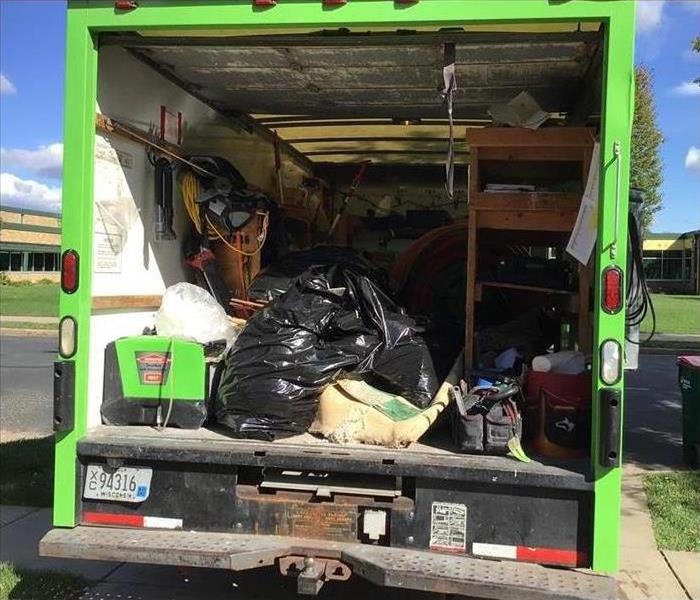 SERVPRO of Stillwater, Oakdale, and Mahtomedi is Here to Help!
SERVPRO of Stillwater, Oakdale, and Mahtomedi is Here to Help!
Advantages Of Opening a SERVPRO Franchise
It is an unfortunate fact that disasters continue to occur regardless of market conditions. As a result, the restoration industry keeps rolling even as other sectors of the economy slow down. Homeowners need habitable residences and commercial property owners need to maintain properties that can attract and retain tenants. Learn more about the advantages of opening a SERVPRO franchise near Bay Port, MN.
There Is Consistent Demand for Services
Rates of fire, water and storm disasters remain relatively consistent year-over-year. Here are several statistics to give a sense of the size of this market:
- The U.S. Fire Administration reports over 1 million fires every year
- The National Flood Insurance Program has over 5 million policies in force
- The National Oceanic and Atmospheric
- The administration reports an average of 1,000 tornadoes per year
These metrics indicate steady demand for damage restoration from fires, flooding and storm damage across the United States. Preferred Vendors in a major restoration company are most likely to be called on during disaster recovery.
Restoration Firms Are Local Businesses
Opening a locally owned SERVPRO franchise is a good way to engage in the local economy with the backing of a large national company. Owners, operators and employees help out with disaster response and recovery close to home and can rely on an extensive network for support.
Franchises Can Join a Large Network
Over 1,700 franchise locations in North America are affiliated with SERVPRO. Membership in this corporate restoration network can be helpful when it comes to responding to large losses or making it easier for owners and employees to get certified through the Institute of Inspection, Cleaning and Restoration Certification programs.
Opening a restoration company is a smart decision, but any business without a corporate network is less protected than a franchise in a large family. SERVPRO franchise owners have access to the resources they need to compete and succeed.
How SERVPRO Can Help With Emergency Response
5/6/2022 (Permalink)
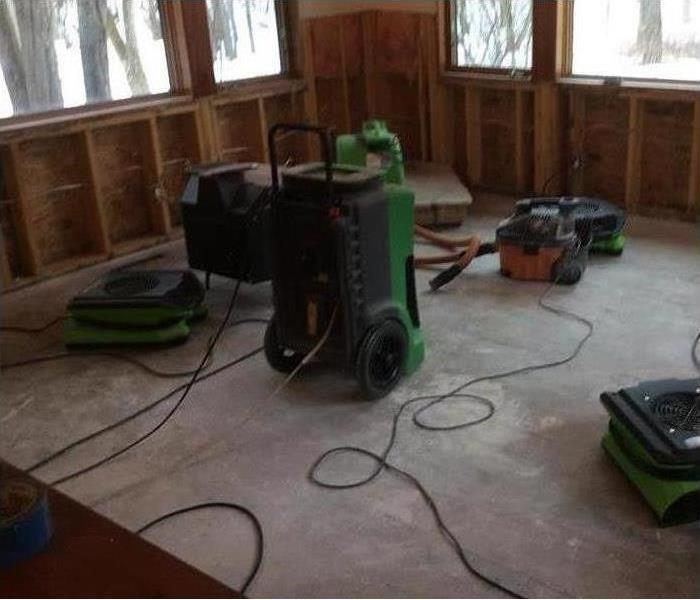 Water cleanup in Lakeland, MN.
Water cleanup in Lakeland, MN.
How SERVPRO Can Assist in an Emergency
When you are in an emergency, time matters. Fortunately, you can make this process easier by going through a damage remediation company in Lakeland, MN. They provide a variety of claim services to help you get back on your feet quickly. They do this by working with your insurance company while performing cleanup services.
Pretesting
SERVPRO can provide comprehensive pretesting services like:
- Assessing the damage
- Stopping problems before they get worse
- Taking an accurate account of what needs to be done and when
Each of these services can prove vital to you resuming your normal business operations.
Emergency Response
They are available during an emergency and have a local emergency response team. This helps to mitigate any incidental damage. They will be able to get to you quickly and are trained to deal with almost every type of emergency. Whether it is a storm, fire or flood that left your business damaged, you can count on them to be there for you quickly.
Claim Services
They can help you with the complicated process of filing the correct insurance claim. They offer services like electronic filing and online access to your claim files. They also work with a vast network of insurance companies, so there is a good chance that they understand any particular company's claims process. This can be invaluable when you just want the problem handled.
Trained Teams
SERVPRO trains all of its response teams in all aspects of fire, water, storm, cleanup and restoration. Their technicians have an Institute of Inspection, Cleaning and Restoration certification. This means that you are getting the absolute best service and people who know what they are doing when it comes to various restoration situations. They also know how to speak with insurance companies and agents to achieve the best result.
When it comes to claim services, you want a company that has a good reputation with insurance companies. Only someone who knows the ins and outs of damage restoration and insurance can give you the best service possible.
The Best Mold Control Strategies for Apartments
4/18/2022 (Permalink)
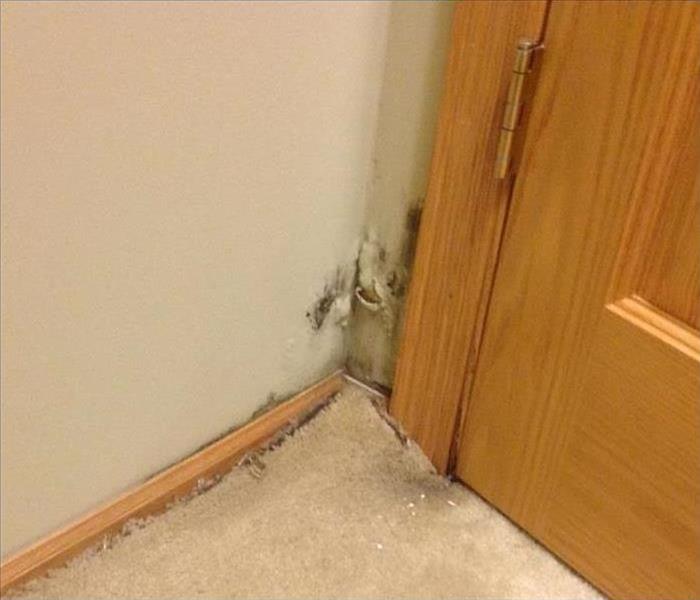 Mold growth in an apartment may spread to other units or common areas in a building.
Mold growth in an apartment may spread to other units or common areas in a building.
The Most Effective Mold Control Techniques for Apartments
Mold growth in an apartment building can affect a single unit, several apartments or a larger area. Discover the best strategies to control the spread of fungus leading up to mold cleanup at a multifamily dwelling in Lakeland, MN.
Keep an Infestation From Spreading
Mold growth in an apartment may spread to other units or common areas in a building. Apartments are often connected to some, if not all, of the following areas:
- Hallways
- Elevators
- Stairways
- Lobbies
- Ventilation
Mold spores can be carried on the clothing and shoes of residents or property maintenance staff. The design of ductwork may also determine how readily mold growing in a single unit or inside air ducts can spread throughout a structure.
Resolve the Underlying Problems
If mold is growing due to conditions within a unit, a property manager or owner should take measures to resolve the problem. A leaky sink, bathroom fixtures or other factors may require containment and mold cleanup in an apartment and surrounding units.
A major mold infestation may result from severe water damage on the structural level. A broken or leaking supply line or damage to the roof of a structure may lead to hidden mold growth behind walls that has the potential to affect multiple apartments.
Promote Mold Mitigation Measures
Whether mold contamination affects a single unit, multiple apartments or a significant portion of a multifamily dwelling, it is important to mitigate conditions. Property owners and managers should respond quickly to reports of water damage and provide complete cleanup and restoration services. If mold is reported, inspection and remediation should take place as soon as possible.
Taking measures to contain the spread of spores, eliminate water sources and maintain low humidity levels can restrain mold growth prior to remediation. These methods may have the potential to limit the scope of mold cleanup at a building in Lakeland, MN.
Everything You Want To Know About the Mold in Your Home
1/31/2022 (Permalink)
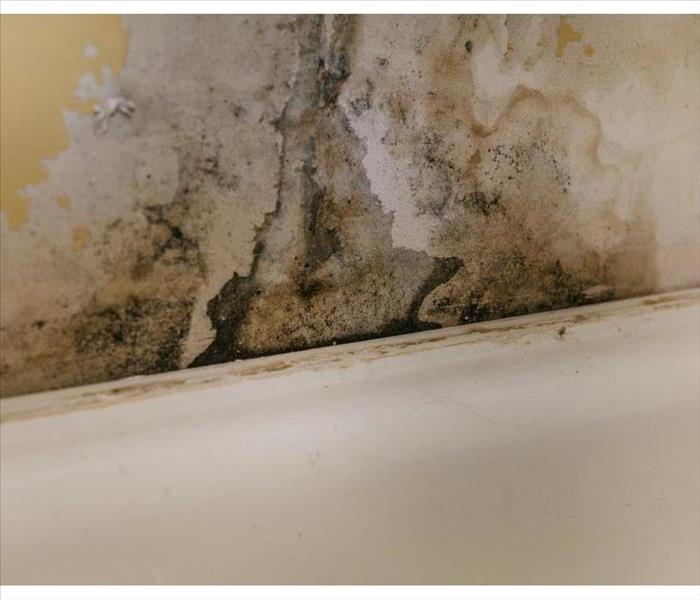 Mold can grow anywhere.
Mold can grow anywhere.
Understanding How Mold Spreads
Black mold has developed a nefarious reputation in recent years. If you have watched news reports or talked to your neighbors, you probably understand how bad this type of mold can be. Still, before you attempt mold cleanup in your Lakeland, MN, house, you should know a few things about mold.
Mold Growth Can Be Essentially Anywhere
Mold spreads through microscopic spores that easily float on wind currents in your house. As such, if you have mold growth in one part of your home, you probably have it in other spaces too. When inspecting your home for mold, be sure you initially look at moist areas. Specifically, view the following spaces to see if you find mold growth:
- Attic
- Basement
- Crawlspace
- Laundry facilities
- Bathrooms
- Garage
- Kitchen
Mold Eats the Organic Things Inside Your home
To thrive, black mold needs a food source. While you can keep the food you eat away from mold, you should realize that it loves to consume other organic things inside your home. Specifically, mold may feed on drywall, carpet, sub-flooring and insulation. Only with a comprehensive examination of your home can you determine if you have mold growth somewhere in your house.
Cleanup Requires Expertise and Equipment
Removing mold from your home is often trickier than it sounds. Because mold spores are often toxic, mold cleanup usually requires the right personal protective equipment. It also usually demands some expertise. Rather than leaving the condition of your house to chance, you may want to work with a mold remediation service. Expert technicians understand where to find mold and how to remove it from your family spaces.
You work hard to have a nice home. Unfortunately, black mold can wreak havoc on the comfort, appearance and value of your house. By understanding how mold spreads, you increase your chances of effectively removing it from your dwelling.
When Nature Becomes an Art Critic
10/12/2021 (Permalink)
 Expert restoring artwork.
Expert restoring artwork.
When Nature Takes on the Role of an Art Critic
When mold begins to overtake your paintings, it can feel like nature is criticizing your taste in art. What’s actually happening, though, is that the paint – particularly in older paintings – and canvas are fertile breeding grounds and food for mold to devour, and the climate in Oakdale, MN may even be contributing to that. So is it possible to save your paintings with mold remediation and mold cleaning, or are they lost forever to the ravages of time and mold damage?
You Can Save It – But Stay Away from Chemicals and Water
Your first instinct may be to attack your paintings with bleach and soapy water. This can ruin your paintings even worse than the mold. Acrylics are water-soluble and will begin to dissolve; oils can react poorly with bleach and other chemicals. You might save the canvas, but you’ll lose the art. Cleaning a painting suffering from mold damage is a delicate process involving:
• Dry brushing. A soft bristle brush can be used to dry brush and remove multiple types of mold, although one should be gentle.
• A mild mix of alcohol and water applied only to the back of the painting; applying to the front can dissolve the paint.
• Careful wiping with a barely-dampened cloth with water and no chemicals. Don’t use a cloth wet enough to cause damage to the paint.
• Sunning to destroy the mold. Be delicate with this, as sun exposure can also ruin paintings. Use sunlight as a deterrent in short periods before returning to cleaning with dry brush methods again.
Prevention Is the Best Measure
Mold cleaning is difficult when it comes to a prized piece of artwork. While some can be restored, it’s better to avoid altogether by preventing mold exposure with your precious art. Keep your art stored in a cool, dry place above any normal flood levels for your area. If necessary, contact art preservation specialists about mold cleaning and prevention.
Rain Rain Go Away
6/4/2021 (Permalink)
 Debris from trees still falls on your roof.
Debris from trees still falls on your roof.
During the winter months we talk a lot about watching your roof and gutters for ice buildup, to help avoid ice dams. Today we are going to talk about your house gutters again, but only with a non-winter slant. It may not be fall yet, but debris from trees still falls on your roof, the usual leaves or sticks on a winter day, or the really messy dried pine needles. All of which can plug your gutters and cause rain run off to flow over the edge and collect around your foundation.
We suggest that you periodically check your gutters and remove the buildup. Especially when the weather man is predicting a heavy rain fall. If the water over flows and lands around your foundation causing an excessive saturation, which can seep into your basement and cause damage. The good news is, SERVPRO can help with the mitigation. The bad news, homeowner’s insurance doesn’t always cover for seepage of this sort in most policies. That’s why it’s a good idea to keep up with your home maintenance to avoid having to call us out.
Spring Cleaning Tips for Homeowners
4/21/2021 (Permalink)
 Long days and warmer temperatures make for a great time to do a little spring cleaning.
Long days and warmer temperatures make for a great time to do a little spring cleaning.
Winter has finally started to thaw and the chill in the air is beginning to fade away. Even if you live in a warmer climate with mild winters, springtime brings longer days. Those long days and warmer temperatures make for a great time to do a little spring cleaning.
As a homeowner, your spring-cleaning routine should include a little more than just scrubbing the bathrooms and vacuuming the floors. You can use spring as a time to check up on parts of your home that affect property value and longevity of your house. Our list of spring-cleaning tips for homeowners gives you some ideas for not only cleaning your home but making sure all systems are running correctly.
Remove Dust and Built-Up Dirt
Just like a regular house cleaning, your spring-cleaning routine should include a complete scrub down of your home. You can sweep, vacuum and mop floors to pull up the dust and grime that has built up over winter. Dust along molding and floorboards to pick up the dirt that has settled there. Ceiling fans tend to collect a lot of dust over the winter, so be sure to wipe them down thoroughly using a vacuum attachment or old pillowcase for dusting. Also, be sure to check that the fan is rotating in the correct direction. In spring and summer, you want it to spin counter-clockwise by pressing the switch on the fan’s side. As hot air rises, the counter-clockwise rotation forces cool air down towards the floor.
Do the Laundry
You’ve been doing laundry all winter so you’ll have clean clothes to wear, of course, but spring is a great time to air out warm-weather clothes and linens. Perhaps you use heavier sheets, such as flannel sheets, in the cooler winter months. Use your spring-cleaning day to pull out lighter bedding and wash the winter sheets before storing them until next winter. Alternatively, you might just want to switch up your color palette or décor for the warmer months. Many people switch to a light color scheme for the warmer months. Fresh colored bedcovers such as green, yellow and light blue can help welcome spring into your home.
While you’re doing your laundry, make sure to clean out your washer and dryer and check them for any issues. Be sure that the water lines running to your washing machine aren’t leaking. Give the tub of the washer a good rinse and sweep or vacuum behind and underneath the machine. You will probably also want to do this with your dryer, as well as checking that the vent is properly connected and vents cleanly outside your home.
Check Pipes and Water Lines
An increase in your monthly water or utility bill could be a signal that you have a burst or leaking pipe. Water damage in your home can be a costly expense that is a pain to deal with. Even if you don’t suspect a leak, springtime is a great opportunity to look through your home for any potential leaks or cracks. Check each of your faucets, including the ones outside your home, to make sure that they aren’t dripping. In bathrooms, you should inspect the areas around bathtubs, showers and toilets for leaking or damaged caulking so you can fix it before it becomes an issue.
Service Heating and Cooling Systems
Your heating and cooling units might be some of the most expensive and important equipment in your home. Luckily, these systems tend to have a long life with proper care. Proper maintenance of your heating and cooling systems can save you a lot of money, and a lot of hassle down the road. Spring makes an excellent time to have your heating system checked out after running it all winter. Your air conditioner, likewise, could likely use a checkup from a professional before using it through the hot summer months. You may need to replace things like air filters that have gotten filled with dust and dirt.
Declutter Closets and Storage
Spring cleaning is an ideal time for going through old winter clothes or items and getting rid of things you don’t need. Go through each of the closets or storage spaces in your home and make three piles of the items you find. One will be for keeping, one for donating to charity and one for tossing out in the garbage or recycling. Put your items into their respective piles to help declutter your home. This exercise is also great for making a home inventory list. Home inventory lists are a breakdown of the items in your home that could assist you when filing a homeowners insurance claim. Your list should include important items you would want to be replaced and a short description of each item, including brand and serial number if possible.
Let in Fresh Air While Checking Windows and Doors
One of the best parts of a spring-cleaning day is the chance to let in fresh new air and let out the stuffiness of winter. You can open up all your doors and windows while cleaning to enjoy the sunshine and the springtime breeze. Not only does this make your home feel refreshed, but it also gives you a chance to look at doors and windows for signs of damage or leaks. Be sure to check the caulking around the windows and doors. Sunshine and exposure to the elements can cause caulk to dry out or flake off. Also, check for signs of water damage anywhere around your windows or doors. This might indicate you have a leak from a broken seal.
Clean Gutters
Over the winter, your gutters may have gotten clogged with debris from trees, birds or squirrels. You can either hire a service to clean your gutters for you or you can clean them yourself. If you choose to clean them yourself, remember to be cautious when using a ladder. Always have someone there to help you and hold the ladder for stability.
Check Roofing
A new roof is an incredibly expensive undertaking, so it’s important to keep your current roof in the best shape possible. Check your roof for signs of stress or damage. This might include missing, broken or loose shingles. Additionally, check shingles to make sure they haven’t lost their protective layer. That gritty, asphalt-like substance on a roof tile protects it from the sun’s harmful UV rays. Just like with gutter cleaning, you will want to use caution and have a friend on the ground when you’re up on your roof.
Touch Up Peeling Paint
Peeling or cracking paint on a home never looks good. Even if it’s just cosmetic, peeling paint may lower the overall value and curb appeal of your home. It’s also usually a fairly easy fix. For homes with a lot of peeling paint, or cracked paint in hard-to-reach places, consider hiring a professional contractor to take care of the work for you. If you have a few small spots, you might want to take on the project yourself.
Refresh and Renew Your Home with a Spring Cleaning
A good spring cleaning helps your home feel refreshed and renewed for the warm season. Additionally, spring cleaning gives you the chance to go through your home’s important equipment and systems. You’ll be able to ensure everything is working properly and should be able to feel confident enjoying your home throughout the sunny spring and summer months.
6 Ways to Save on Electric Bills
4/16/2021 (Permalink)
 When you’re looking for ways to save money, lowering your bills should be a top priority.
When you’re looking for ways to save money, lowering your bills should be a top priority.
When you’re looking for ways to save money, lowering your bills should be a top priority. Some bills are easy to lower, such as that premium cable subscription you never use. Others might seem impossible to cut down.
If you’re like a lot of people, you’d love to lower your electric bill, but you’re not sure where to start. The good news is there are a lot of little changes you can make to help cut energy costs. Start by trying these six simple tips to lower your electric bill.
- Program Your Heating and Cooling
There are a lot of fancy smart-home devices available today, and they can get pretty expensive. Luckily, you don’t need to spend a fortune to add a few smart elements that can help cut your power bills.
Start with a programmable thermostat. You can opt for a top-of-the-line smart thermostat or a simple programmable one. Some smart thermostats allow you to change your home’s temperature from your smartphone remotely. Even a simple programmable thermostat lets you set the temperature in your home for specific times of the day.
Programming your heating and cooling saves you money on electricity by maximizing efficiency when you need it most. In the summer, you could set the thermostat to start running the air conditioning about an hour before you get home from work in the evening. You’ll come home to a cool house while not wasting money cooling the house when no one’s home.
- Unplug Appliances When Not in Use
It’s not always easy to tell if an appliance or gadget is using electricity when it’s turned off, but a lot of them do. Even if you hit the “off” button, leaving an appliance plugged in could be costing you money.
You can cut this unnecessary expense by unplugging appliances when you’re done with them. After making breakfast, unplug the toaster so it doesn’t sap energy till the next morning. You can do the same with almost any appliance or tool in your home — from gaming consoles and televisions to coffee makers and microwaves.
Unplugging all of your appliances after each use might seem inconvenient. Once you’re in the habit, however, you’ll enjoy a lower electric bill while also reducing your chance of overloading an outlet and causing a home fire.
- Wash Your Clothes in Cold Water
Traditional clothes-washing wisdom might tell you to use hot water to get your clothes clean. That’s because laundry detergents of the past needed the heat from hot water to activate. Most modern detergents, however, can work just as well in cold water as hot.
This is good news for your wallet since heating the water for a load of laundry uses a lot of energy. By washing clothes in cold water, you’re reducing the amount of electricity you need.
As a bonus, you’ll also get more use out of your clothes. Cold water is generally less harsh on your clothing than hot water. Hot water can cause fibers to break down and lead to shrinking, running dyes, or faded colors.
Make your laundry even more energy-efficient by skipping a cycle in the hot dryer. You can line-dry your clothes for similar benefits — you’ll save money on energy costs and your clothes won’t be exposed to extreme heat.
- Wear the Right Clothing
It may sound silly but wearing the right clothes indoors can help reduce your heating and cooling costs, ultimately lowering your electric bill.
In the winter, you might be tempted to crank the heater and start a cozy fire in the fireplace. After a while, you realize you’re warm. Instead of turning down the heat or putting out the fire, you change into shorts and a tank top to beat the heat.
In the summer, you could end up doing the opposite. You run the air conditioner so the house is cold, then pull on a sweatshirt or long pants because you’re chilly.
Most of the time, you probably don’t realize you’re changing to match your current comfort level. The next time you reach for an extra layer or change into summer clothes in the winter, try adjusting your home’s thermostat instead.
- Maintain Your HVAC System
Your heating and cooling system has to work hard to give you an ideal indoor temperature, especially if the outdoor temperature is extreme. The best way to keep your HVAC system from running up your electric bill is to practice proper maintenance.
The easiest step is to replace your air filter regularly. The air filter works to keep debris, dust, and allergens out of the air in your home. As the particles collect in the filter, the system has to work harder to move air through. Check your air filter regularly. If it’s dirty and dusty, it’s time to replace it.
You should also consider hiring a professional HVAC technician to service your system each year. A professional will have the tools and knowledge to alert you if there are any issues and clean your system so it’s running properly.
- Keep Your Appliances in Good Condition
A dirty appliance in need of repairs often costs a lot more to run than a clean one. Reduce your energy costs by keeping your appliances in good repair. If you notice an appliance isn’t running as efficiently, such as a dryer not drying clothes, clean out dust, dirt, and buildup or contact a repair company.
When your appliance gets beyond repair, you might want to think about replacing it with a newer, more efficient model. Many modern appliances are designed to reduce energy costs and may even come with a rebate from your local power company.
Reducing your energy expenses can be easy is you follow these six steps. Remember to monitor your monthly bill to see the impact these costing-saving ideas can have on your electric bill.
8 Spring Home Maintenance Projects You Should Do This Season
4/6/2021 (Permalink)
 Spring brings longer days and warmer weather, both of which make it easier for us to plan and take on important spring home maintenance tasks.
Spring brings longer days and warmer weather, both of which make it easier for us to plan and take on important spring home maintenance tasks.
Spring brings longer days and warmer weather, both of which make it easier for us to plan and take on important spring home maintenance tasks. From repairing property damage to preparing for summer, there are a number of things that we should do to “tune up” a home’s major systems and features. Doing so doesn’t just maintain your home’s property value – it also helps to prevent bigger breakdowns and repairs down the line.
Not sure where to start? These 8 basic maintenance needs are each worth your attention this month:
Get Your HVAC Inspected
If there is one system you always want to be functional, it’s your heating, ventilation, and air conditioning system. All too often, people skip spring maintenance only to find their system breaking down during the hot summer. Rather than losing the comforts of home during a heat wave, you should hire a licensed professional to service the equipment before the start of summer. Just be sure to discuss any health and safety measures needed during your appointment this spring.
Clean Your Dryer Vent
One of the biggest fire hazards in your home is a clogged dryer vent. Fortunately, you can prevent this hazard by cleaning out your dryer vents each spring.
Check Your Windows’ Caulking
Caulk, the material used to seal the seams around your windows both inside and outside your home, doesn’t last forever, and its breakdown leads to air drafts and water leaks. It’s important to check the caulking in your home every spring for tears, cracks, or gaps. Should you find damaged caulking, it will need to be replaced, either by you or a professional.
Inspect Your Home’s Woodwork
Because it’s exposed to the elements, exterior woodwork requires lots of maintenance. Each spring, you should inspect the state of your wood decks, fences, railings, trellises, pergolas, and other outdoor structures.
In addition to planning necessary repairs and addressing wood rot, you should also plan on staining or resealing these structures every year or two. During your inspection, you should also check for signs of termites, as these insects need to be addressed by pest control sooner rather than later.
Examine Your Roof
Roof maintenance is one of the most important parts of home ownership. Are the shingles in place? Are the vent pipes, flashing, or anything else damaged? Answering these questions annually can help you spot small issues before they become big ones. If you notice anything that needs closer inspection or repair, the next step is to call a roofer, who can work with you to safely determine your next steps.
Clean Your Gutters
While not exactly a favorite chore around the house, cleaning your home’s gutters is extremely important. Blocked or damaged gutters can’t do their job during those numerous spring rain showers. Clogged gutters can also lead to wood rot, pest infestations, and other problems. So debris needs to be removed from gutters each spring, and you should also check that downspouts are still turned away from your home. Additionally, make sure water isn’t collecting at the foundation of your home.
Pressure Wash Your House
Rain, leaves, dust, and other outdoor elements tend to create a buildup of residue on your home’s exterior. In the worst cases, this buildup can lead to green mold! So it’s best to pressure wash the outside of your house each spring to prevent this. At the very least, the annual wash will add shine to your property!
Check Your Basement
In addition to examining exterior elements and essential household systems, you should also examine the state of your basement each spring. Because moisture is a common problem in basements, these are easy places for mold and other types of fungus to grow. To prevent a serious problem from developing, you should examine your basement each spring for signs of moisture or water damage.
These home maintenance projects each play an important part in keeping your home in good condition. Not only will they help you live comfortably and safely – but they’ll also be important should you look to sell your house at some point. So be sure to schedule time to complete each maintenance item this spring.
Be Prepared to Stay Safe and Healthy in Winter
3/16/2021 (Permalink)
 Winter storms and cold temperatures can be dangerous.
Winter storms and cold temperatures can be dangerous.
Winter storms and cold temperatures can be dangerous. Stay safe and healthy by planning ahead. Prepare your home and vehicles. Prepare for power outages and outdoor activity. Check on older adults.
Although winter comes as no surprise, many of us may not be ready for its arrival. If you are prepared for the hazards of winter, you are more likely to stay safe and healthy when temperatures start to fall.
Prepare Your Home
Staying inside is no guarantee of safety. Take these steps to keep your home safe and warm during the winter months.
- Winterize your home.
- Install weather stripping, insulation, and storm windows.
- Insulate water lines that run along exterior walls.
- Clean out gutters and repair roof leaks.
- Check your heating systems.
- Have your heating system serviced professionally to make sure that it is clean, working properly, and ventilated to the outside.
- Inspect and clean fireplaces and chimneys.
- Have a safe alternate heating source and alternate fuels available.
- If you do not have a working smoke detector, install one. Test batteries monthly and replace them twice a year.
- Prevent carbon monoxide (CO) poisoning emergencies.
- Install a CO detector to alert you of the presence of the deadly, odorless, colorless gas. Check or change the battery when you change your clocks in the fall and spring.
- Learn the symptoms of CO poisoning: headache, dizziness, weakness, upset stomach, vomiting, chest pain, and confusion.
Get your vehicle ready for cold weather use before winter arrives.
Prepare Your Vehicle
Get your vehicle ready for cold weather use before winter arrives.
- Service the radiator and maintain antifreeze level.
- Check your tires’ tread or, if necessary, replace tires with all-weather or snow tires.
- Keep the gas tank full to avoid ice in the tank and fuel lines.
- Use a wintertime formula in your windshield washer.
- Prepare a winter emergency kit to keep in your car in case you become stranded. The kit should include:
- Cell phone, portable charger, and extra batteries;
- Items to stay warm, such as extra hats, coats, mittens, blankets, or sleeping bags;
- Food and water;
- Booster cables, flares, tire pump, and a bag of sand or cat litter (for traction);
- Compass and maps;
- Flashlight, battery-powered radio, and extra batteries;
- First-aid kit; and
- Plastic bags (for sanitation).
Prepare for Emergencies
Be prepared for weather-related emergencies, including power outages.
- Stock food that needs no cooking or refrigeration and water stored in clean containers.
- Ensure that your cell phone is fully charged.
- When planning travel, be aware of current and forecast weather conditions.
- Keep an up-to-date emergency kit, including:
- Battery-operated devices, such as a flashlight, a National Oceanic and Atmospheric Administration (NOAA) Weather Radio, and lamps;
- Extra batteries;
- First-aid kit and extra medicine;
- Baby items; and
- Cat litter or sand for icy walkways.
- Protect your family from carbon monoxide (CO).
- Keep grills, camp stoves, and generators out of the house, basement and garage.
- Locate generators at least 20 feet from the house.
- Leave your home immediately if the CO detector sounds, and call 911.
Wear appropriate outdoor clothing: layers of light, warm clothing; windproof coat, mittens; hats; scarves; and waterproof boots.
Take Precautions Outdoors
Outdoor activities can expose you to several safety hazards, but you can take these steps to prepare for them:
- Wear appropriate outdoor clothing: wear a tightly woven, preferably wind-resistant coat or jacket; inner layers of light, warm clothing; mittens; hats; scarves; and waterproof boots.
- Sprinkle cat litter or sand on icy patches.
- Learn safety precautions to follow when outdoors.
- Work slowly when doing outside chores.
- Take a buddy and an emergency kit when you are participating in outdoor recreation.
- Carry a cell phone.
Do This When You Plan to Travel
When planning travel, be aware of current and forecast weather conditions.
- Avoid traveling when the National Weather Service has issued advisories.
- If you must travel, inform a friend or relative of your proposed route and expected time of arrival.
- Follow these safety rules if you become stranded in your vehicle.
- Make your vehicle visible to rescuers. Tie a brightly colored cloth to the antenna, raise the hood (if it is not snowing), and turn on the inside overhead lights (when your engine is running).
- Move anything you need from the trunk into the passenger area. Stay with your vehicle unless safety is no more than 100 yards away.
- Keep your body warm. Wrap your entire body, including your head, in extra clothing, blankets, or newspapers. Huddle with other people if you can.
- Stay awake and stay moving. You will be less vulnerable to cold-related health problems. As you sit, keep moving your arms and legs to improve circulation and stay warmer.
- Run the motor (and heater) for about 10 minutes per hour, opening one window slightly to let in air. Make sure that snow is not blocking the exhaust pipe—this will reduce the risk of carbon monoxide (CO) poisoning.
Be ready to check on family and neighbors who are especially at risk from cold weather hazards: young children, older adults, and the chronically ill.
If you have pets, bring them inside. If you cannot bring them inside, provide adequate, warm shelter and unfrozen water to drink.
No one can stop the onset of winter. However, if you follow these suggestions, you will be ready for it when it comes.
SERVPRO is Here to Help During This Time of Need
3/11/2021 (Permalink)
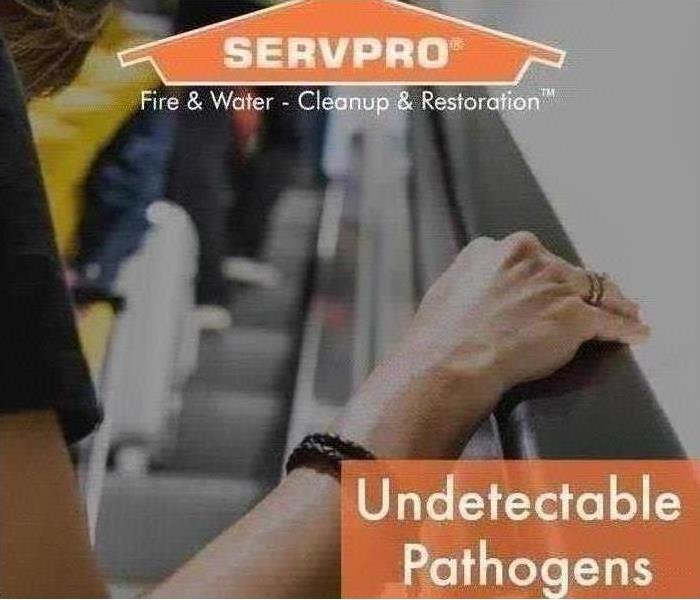 We are prepared to clean and disinfect your home or business.
We are prepared to clean and disinfect your home or business.
During this unprecedented time caused by the global pandemic of corona virus, this is a reminder to our customers that we are specialists in cleaning services, and we adhere to the highest cleaning and sanitation standards.
Specialized Training
We are prepared to clean and disinfect your home or business, according to protocols set forth by the Centers for Disease Control and Prevention. We have years of experience in dealing with biological contaminants, and we will go beyond the scope of work that regular janitorial staff perform on a daily basis.
The CDC encourages cleaning of high-touch surfaces such as counters, tabletops, doorknobs, light switches, bathroom fixtures, toilets, phones, keyboards, tablets and tables. Other spaces mentioned in the CDC’s guidance for commercial spaces include:
- Kitchen/Food Areas
- Bathrooms
- Schools/Classrooms
- Offices
- Retail Spaces
- Water Fountains
- Shelving/Racks
- Sales Counters
- Carpets and Rugs
- Stair Handrails
- Elevator Cars
- Playground Equipment
- Fitness Equipment
Specialized Products
The CDC recommends usage of a labeled hospital-grade disinfectant with claims against similar pathogens to the corona virus. Multiple products in the SERVPRO product line carry the EPA-approved emerging pathogens claims. While there is currently no product tested against this particular strain of the corona virus, we are following all guidelines as provided by the CDC and local authorities.
Please follow our page, as we continue to explore the benefits of mitigation, and how this approach helps both your clients and your business. Please call us with any questions you have, 651-705-7028. Visit our site: SERVPRO of Stillwater, Oakdale, & Mahtomedi
It’s National Preparedness Month: Make a plan
9/4/2020 (Permalink)
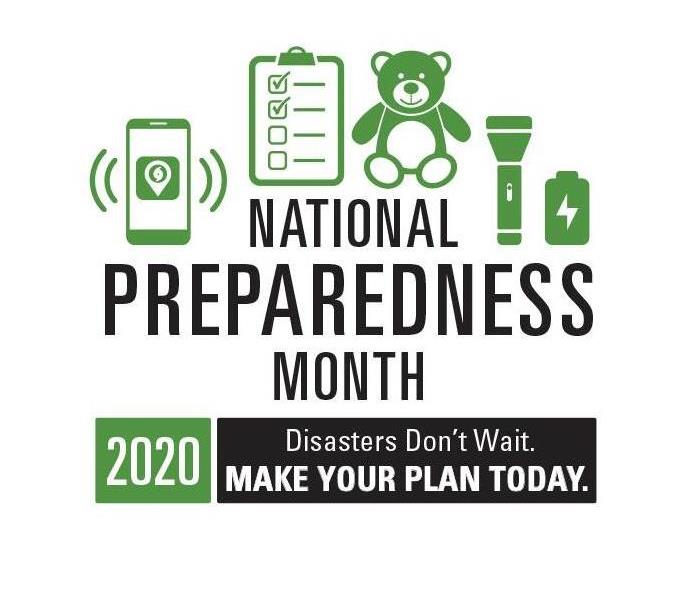 Extreme weather and natural disasters can occur with little warning.
Extreme weather and natural disasters can occur with little warning.
Extreme weather and natural disasters can occur with little warning. This year’s floods and wildfires are proof of that. Are you ready to leave your home at a moment’s notice? You can reduce your anxiety about these scary events by making sure you are prepared if and when they happen. September is National Preparedness Month and a good time to get your family, pets, and property ready. You can, for example:
- Organize your finances. When it comes to preparing for situations like weather emergencies, financial readiness is as important as a flashlight with fully charged batteries. Having your financial documents up-to-date, in one place, and portable can make a big difference at a tense time.
- Replace missing documents. If you’re missing important documents, now’s the time to replace them.
- Check your insurance. Find out if any of your home, health, or other insurance policies will pay for temporary shelter, replacement clothing, furniture, or other items if you are affected by extreme weather or a disaster.
- Prepare your home. From floods to fires, earthquakes, high winds and tornadoes, check out The Federal Emergency Management Agency’s (FEMA) How-To Series: Protect Your Home or Business. If you live where storms and flooding are likely, visit floodsmart.gov to learn about FEMA’s National Flood Insurance Program.
- Plan for your pets. If you’re like millions of animal owners nationwide, your pet is an important member of your household. A little planning today can help ensure safety for your pets during an emergency.
- Sign up for alerts and warnings in your area. Public safety officials use timely and reliable systems to alert you and your family in the event of severe weather and disasters.
Please follow our page, as we continue to explore the benefits of mitigation, and how this approach helps both your clients and your business.
We Answer The Phone
7/21/2020 (Permalink)
 "Guess what! We answer the phone!"
"Guess what! We answer the phone!"
Not a week goes by that we don’t get a call from a new client in desperate need of help. At the end of the phone call our office staff always asks, so how did you hear about SERVPRO? Most of the time we get an answer like my parents, neighbor, or a friend used your services in the past. Or, we looked you up on line, or saw your social media page. Not a month goes by that we don’t get a call, where the answer is, you are the only ones that answered my call. When people call us, it’s usually not because something fun and exciting happens. It’s usually on one of their worst days that they call us. When you are having a bad day, you just want someone to respond and help.
Guess what! We answer the phone! When a franchise’s office is closed for the night, the weekend, or a holiday we are still on call and answering the phone. SERVPRO headquarters has a 24 hour call center that routes all calls to the appropriate franchise. Each franchise has a dedicated person answering the phone 24 hours a day, even in the middle of the night. And finally techs are on a rotating on call schedule to make sure we can gets boots on the ground of any emergency when the calls come in.
Please follow our page, as we continue to explore the benefits of mitigation, and how this approach helps both your clients and your business. Please call us with any questions you have, 715-381-2266. Visit our site: SERVPRO of Stillwater, Oakdale, & Mahtomedi
Mold In The Attic
4/14/2020 (Permalink)
If you’re like most of us, you rarely if ever venture into your home’s attic. Why would you? It’s not usually a place you care to venture and for the most part if you do it’s because something isn’t going well. With warmer temps here for the summer, we start to see an increase in jobs where homeowners have discovered mold damage in their attic. In this blog post, we’ll talk through what we typically see when homes have considerable amounts of attic mold and help you understand ways you can make sure it doesn’t happen to you.
Why mold grows in attics
Mold damage in your attic space occurs for the same reasons it occurs anywhere else in a dwelling. It’s a combination of a few things:
() the right temperature – mold spores like warmer, ambient temps. In fact, it likes about the same temp range as we do, between 60-80 degrees Fahrenheit.
() food – no, not crumbs from discarded food a home service technicians might have left while doing some work up in your attic long ago. Mold likes anything that is high in cellulose. Unfortunately for homeowners, that’s pretty much anything in your attic, like plywood, wood joists, roof decking, etc.
() elevated moisture – many homeowners don’t realize that moisture is found in every surface of their home, as it should be. If those surfaces were completely devoid of moisture they wouldn’t perform their duties properly. But if a surface gets too much moisture in it, that’s the trigger mold needs to start growing. Another thing most homeowners don’t realize is that mold spores are present in most environments, and certainly in every home or other type of dwelling. It exists naturally and in low levels and is completely harmless to humans and pets. But with the right conditions, it can grow quickly and spread, causing wide spread damage to your home and potentially cause health effects for the home’s inhabitants.
As you can see from the list above, 2 of those things are normal. It’s the 3rd thing, elevated moisture that is not normal and creates the right environment for a mold problem. So now let’s talk through how moisture gets into attics and what you can do to make sure it doesn’t get into yours.
Causes of attic mold growth
When we are called to a home and discover mold in the attic, the culprits are usually pretty easy to spot. There are only so many ways moisture finds its way into an attic. Here’s what we usually see:
Venting directly into the attic
Many bathrooms are equipped with vents that take the warm, wet air released when a shower is running and remove it from the bathroom. Unfortunately, sometimes a misguided homeowner or shoddy handyman will simply install the vent fan such that the air is pushed into the attic where it has nowhere to escape. Bathroom fans should be vented to the outside of the house. If you have an older home that is equipped with one or multiple of these types of exhaust fans, it’s probably worth you taking a look in the attic space to make sure it’s vented properly.
A leaky roof
One culprit we find when inspecting an attic with mold is a leaky roof. Just one damaged or misplaced shingle can allow rain water to slowly seep into your attic. While most people picture a deluge of water coming through their ceiling, more often than not, a roof leak will just allow a slow amount of rain water to enter the attic, usually soaking the roof deck and eventually dripping down onto the attic floor and/or your exterior walls. We recommend that you (safely) inspect your roof’s exterior each spring and it’s also a good idea to just crawl up into your attic and peer at the interior decking of the roof. If you start to see staining, it’s a sign you have some moisture intrusion that needs to be addressed!
Improper Ventilation
Your attic needs to breathe. When we have extended periods of extremely cold weather like we had this past winter, warm air leaks from the interior of your home into the attic. This warm wet air will condensate on the roof deck and possibly ice over the ventilation. One it warms up, this frost will thaw causing the roof deck to get wet. One sign to look for is roofing nails that are rusty. We recommend working with an insulating contractor to make sure your attic vents well so you can avoid this problem.
With a few simple steps and things to be mindful of your attic can remain trouble free. If you suspect you have a problem feel free to give us a call. 651-705-7028
SERVPRO is Here to Help during this time of need
4/13/2020 (Permalink)
During this unprecedented time caused by the global pandemic of corona virus, this is a reminder to our customers that we are specialists in cleaning services, and we adhere to the highest cleaning and sanitation standards.
Specialized Training
We are prepared to clean and disinfect your home or business, according to protocols set forth by the Centers for Disease Control and Prevention. We have years of experience in dealing with biological contaminants, and we will go beyond the scope of work that regular janitorial staff perform on a daily basis.
The CDC encourages cleaning of high-touch surfaces such as counters, tabletops, doorknobs, light switches, bathroom fixtures, toilets, phones, keyboards, tablets and tables. Other spaces mentioned in the CDC’s guidance for commercial spaces include:
- Kitchen/Food Areas
- Bathrooms
- Schools/Classrooms
- Offices
- Retail Spaces
- Water Fountains
- Shelving/Racks
- Sales Counters
- Carpets and Rugs
- Stair Handrails
- Elevator Cars
- Playground Equipment
- Fitness Equipment
Specialized Products
The CDC recommends usage of a labeled hospital-grade disinfectant with claims against similar pathogens to the corona virus. Multiple products in the SERVPRO product line carry the EPA-approved emerging pathogens claims. While there is currently no product tested against this particular strain of the corona virus, we are following all guidelines as provided by the CDC and local authorities.
Please follow our page, as we continue to explore the benefits of mitigation, and how this approach helps both your clients and your business. Please call us with any questions you have, 651-705-7028.
Independent Franchises, But One National Team
4/13/2020 (Permalink)
As with anyone in sales, I get asked one question more than any other. What’s makes SERVPRO different then the next restoration company? It’s a great question to ask, and really struck me as I was at a vendor convention hosted by an insurance company. Sitting there at our booth I could see that the majority of vendors at this adjusters convention offered the same type of services we did. They all did water and fire damage restoration and mold mitigation. Some also did the same types of cleaning services we offer. Others included the mitigation and reconstruction of the structure as well. So what really does make us different?
It really starts with the fact that we are a national company, with independent owner operators. Our partners at SERVPRO Headquarters in Tennessee, set the tone for how operations are carried out. Be it from a piece of equipment that is tested and put through the ringer to make sure it will hold up in the field for our techs. Or the fact that when a disaster strikes we can quickly mobilize and send resources from around the country to help. We truly are faster to any size disaster.
None of this works though without the men and women at the franchise level. Be it the normal daytime routine, or reporting to the scene of a disaster in the middle of the night, SERVPRO techs answer the call knowing that they are walking into most people’s worst nightmare, and are the calming voice of reason and reassurance to our clients. They aren’t comic book heroes, but they do save the day on a regular basis.
Finally, we answer the phone! When a franchise’s office is closed for the night, the weekend, or a holiday we are still on call and answering the phone. SERVPRO headquarters has a 24 hour call center that routes all calls to the appropriate franchise. Each franchise has a dedicated person answering the phone 24 hours a day, even in the middle of the night. And finally techs are on a rotating on call schedule to make sure we can gets boots on the ground of any emergency when the calls come in.
Please follow our page, as we continue to explore the benefits of mitigation, and how this approach helps both your clients and your business. Please call us with any questions you have, 651-705-7028. Visit our site: http://www.SERVPROcentralwashingtoncounty.com/
6 Steps to a Professional Kitchen Hood Cleaning
4/13/2020 (Permalink)
Regular cleanings of restaurant kitchen hood vents are an essential part of any fire safety maintenance plan. Without regular attention, oil and other debris can build up in the hood, exhaust fan, filters and ductwork, significantly increasing the chances of a grease fire. Undergoing a hood cleaning twice a year will help you meet the National Fire Protection Agency’s (NFPA) standards for reducing the risk of fire. This process typically takes between three and six hours. To help you prepare for your upcoming appointment, here’s a guide to what to expect during this procedure.
What Happens During a Professional Hood Cleaning?
- Kitchen Prep
Hood cleaning may create a mess, so the cleaning company will begin by prepping the kitchen for the process. This includes turning off pilot lights and gas valves, covering appliances, and removing any items that could potentially get contaminated by the cleaning chemicals and dirty water. The cleaning crew will also remove all filters and disassemble any wall-mounted hoods and fans for cleaning.
- Filter Cleaning
Kitchen exhaust filters often become caked in grease and grime. The hood cleaning process involves removing the filters and soaking them in a cleaning solution to loosen the hardened grease. After several hours, the filters are power-washed and then reinstalled.
- Fan Cleaning
Kitchen exhaust fans are another place where grease builds up. Fire safety maintenance requires the fans to be removed for a thorough cleaning from top to bottom to reduce hidden hazards. The crew will spray the fan with degreasing chemicals and then scrub the blades clean by hand and power washing. Before the fans are reinstalled, the entire system is inspected and the fan belts replaced to ensure it’s in working order.
- Vent & Ductwork Inspection
NFPA guidelines require that all exhaust duct systems be cleaned and degreased regularly, so a thorough hood cleaning includes manually scraping any solidified grease from the vents and ducts before spraying on chemicals to dissolve the remaining grease. After a final scrub, the vents and ductwork are inspected to ensure they comply with NFPA rules.
- Power Washing
Once the fans, vents, and filters are clean, the crew will tackle the kitchen hoods themselves. This begins with manually scraping congealed grease from the hood, and then applying a degreasing cleaning chemical to loosen any remaining residue. After 30 to 60 minutes, the cleaners power-wash the hood with hot water, leaving it clean and free of grease that could start a fire.
- Inspection & Documentation
The final step of the process happens once the crew has restored the kitchen to its prior condition. This is when the process will be documented and your technician will apply a certification sticker to the unit. This tells health inspectors and insurance companies that you are in compliance NFPA guidelines and have worked with licensed fire protection services to ensure the safety of your kitchen.
If your restaurant kitchen hood needs cleaning, call SERVPRO of Central Washington County at 651-705-7028. Our trained professionals can help many of your professional cleaning and mitigation needs.
Restore vs. Replace
4/13/2020 (Permalink)
SERVPRO of Central Washington County specializes in restoring contents damaged by water, fire, or mold. Our expertise and “restore” versus “replace” mentality can help you save money while preserving precious keepsakes that can’t be replaced. We pretest your belongings to determine what items we can restore to pre-fire condition. We use several methods of cleaning your contents, including:
- Dry Cleaning - Used for cleaning light residues or to pre-clean prior to wet cleaning.
- Wet Cleaning - An effective cleaning method for removing moderate to heavy residues.
- Spray and Wipe -Effective for items that can’t withstand wet cleaning.
- Foam Cleaning - Used for upholstery fabrics that might shrink or bleed if wet cleaned.
- Abrasive Cleaning - Involves agitation of the surface being cleaned.
- Immersion Cleaning - Contents are dipped into a bath of the cleaning product.
Move-Outs/Pack-Outs
If your home requires extensive restoration or cleaning due to fire damage, SERVPRO of Central Washington County can conduct an organized, efficient move-out of the affected area. Move-out will provide several benefits, including:
- A quicker remodeling processes
- Protecting items from potential damage
- Protecting contents from further on-site damage
When restoration is completed, we will work with you to coordinate the move-in according to your needs. The services offered upon move-in may depend on your insurance coverage.
Electronic Cleanup
Fire-damaged electronics can present a serious hazard. Do not attempt to turn on or operate any electrical device that you suspect has been damaged by fire. Smoke residues can contain acids that corrode metal surfaces. If the residues are not removed, corrosion causes electronic failure in the device. We will coordinate the restoration of your electronics, including:
- Television sets
- DVD players
- Computers
- And more
The key to restoring electronics is taking prompt action to prevent further damage. Electronics will be cleaned and inspected by a qualified electronics technician.
Document / Photograph Drying
When your valuable documents, including photographs, are damaged by water or fire, extreme caution should be taken to help ensure the fire damage does not destroy the document. Although some documents may not be restored to pre-fire damage condition, SERVPRO of Central Washington County can save a great deal and help minimize additional damage.
Depending on the type of documents and the level of fire, smoke, or soot damage, they have five options for the restoration of documents:
- Air Drying
- Dehumidification
- Freezer Drying
- Vacuum Freeze Drying
- Vacuum Thermal Drying
Contents Claim Inventory Service
When a fire emergency strikes, the damage can often feel overwhelming. We can help ease the worry and confusion during the recovery process by offering our Contents Tracker by Xactware, which provides a detailed and accurate list of your belongings. We take a room-by-room inventory of your contents, including digital photos, and in some instances, bar coding.
Our Contents Claim Inventory Service:
- Pre-loss list and value of contents
- Detailed and accurate report
- Better information to settle claims quicker
- Assistance with burden of proof for claims
Peace of mind when you need it most!
IICRC Certified Firm
4/13/2020 (Permalink)
SERVPRO of Central Washington County is an IICRC firm. The Institute of Inspection, Cleaning and Restoration Certification (IICRC) creates the standards for the restoration industry and provides training and certification to restoration companies. IICRC Certified Firms have the right to display the IICRC Certified Logo.
IICRC Certified Firms must
• Present accurate information to consumers and conduct business with honesty and integrity.
• Require a technician on all jobs who has been formally trained and passed all required tests.
• Require a continuing education program to keep technicians up-to-date on the latest changes in the industry.
• Maintain liability insurance to protect all parties in the event of an accident.
• Maintain a written complaint policy and agree to Better Business Bureau or similar arbitration to resolve disputes, and accept the conclusions and recommendations of arbitration.
The IICRC Develops The Standards For The Restoration Industry
The IICRC has been the driving force in establishing the main industry standards and reference guides for professional carpet cleaning, water damage restoration and mold remediation. These IICRC standards take years to develop and require the coordination of experts in the field: manufacturers, industry organizations, insurance professionals, training schools, contractors, and public health professionals.
Every five years, the standards are reviewed and updated. The water damage restoration field changes rapidly with advancements in technology and science, and therefore the standards must evolve to keep pace.
About SERVPRO of Central Washington County
SERVPRO of Central Washington County specializes in the cleanup and restoration of residential and commercial property after a fire, smoke or water damage event. Our staff is highly trained in property damage restoration and we are an IICRC Certified Firm. We believe in continuous training: from initial and ongoing training at SERVPRO’s corporate training facility to regular IICRC-industry certification, rest assured our staff is equipped with the knowledge to restore your property.
Our technicians are certified in the following areas:
- Applied Structural Drying
- Commercial Drying Specialist
- Applied Microbial Remediation
- Upholstery & Fabric Cleaning
- Carpet Repair & Reinstallation
In addition, Chris Lick, owner of SERVPRO of Central Washington County has received special recognition from the IICRC as a Master Water Restorer, Master Fire & Smoke Restorer, and Master Textile Cleaner.





 24/7 Emergency Service
24/7 Emergency Service















